Noon. It’s when some people take lunch. It’s when some business people on the east coast schedule their first meetings of the day with clients on the west coast. It’s when others hit the gym for a midday workout.
But come Monday, July 1 at noon, the NHL’s window free agency window officially opens. This year features a bevy of young, elite-level talent in need of a new contract.
Related: 2019 NHL Key Dates To Remember
In an extremely competitive league with a salary cap to drive parity, every general manager (GM) is searching for any and every possible way to gain even the slightest advantage. While theoretically, offer sheets make perfect sense to drive competition, in a predominantly old men’s club, foregoing them is almost an unwritten rule; they rarely happen.
Foundational Talent
This year, it’s possible with so many restricted free agents (RFAs) available, that the stigma surrounding them is finally broken. The list of high-end talent finishing their entry-level contracts this summer is staggering. It includes Mitch Marner, Matthew Tkachuk, Patrik Laine, Sebastian Aho, Brayden Point, Mikko Rantanen, Kyle Connor, Timo Meier, Brock Boeser, Zach Werenski, Ivan Provorov and Charlie McAvoy.
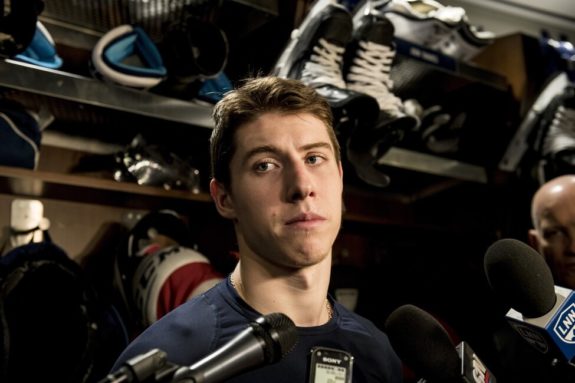
While many of these players may very well sign with their current team, the reality is, they haven’t. Darren Ferris, Marner’s agent and Toronto Maple Leafs’ GM Kyle Dubas didn’t even exchange small talk at the Entry Draft in Vancouver.
The cost to keep young, elite talent isn’t cheap. With an escalating salary cap, it’s likely most of these players wind up making more than Sidney Crosby (12 years at $8.7 million, signed in 2012), Alex Ovechkin (13 years at $9.5 million signed 2008) and Nikita Kucherov (8 years at $9.5 million, signed in 2018). They’ll ink their deals not based on a few strong years, but for hopes of their future production–many strong years ahead while in their prime, high-producing years. It’s a bit of a gamble for GMs to pay massive money over the long term. Locking up a player at a high number now might seem brilliant if the cap has risen 10 percent in five years.
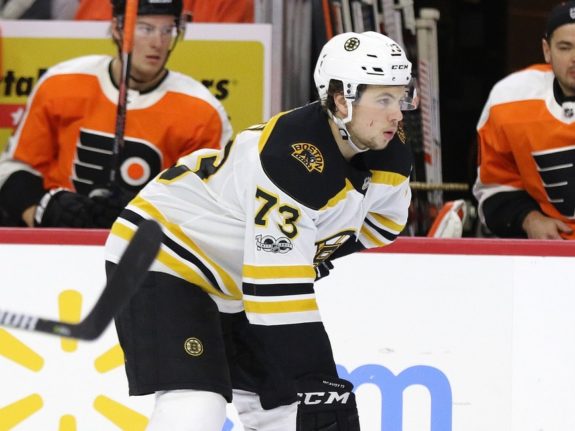
Many agents and GMs have referenced offer sheets and used them as a threat in negotiation tactics. Dubas has until Monday to lock up Marner or he may lose him. Marner may have met with several teams when the window for doing so opened July 26.
Making Money, Chasing Dreams
It’s hard to argue with professional hockey players or their agents; who want to maximize their earnings during a limited window while playing the game they love. Players are also the ones who took a hard stance against a hard salary cap which led to an entire 2004-05 season being cancelled. Team owners eventually got their way with a hard cap, so it’s their responsibility to make it work.
On the flip side, athletes want to win. They want to fulfill an almost mystical childhood dream and raise a storied trophy above their head just as they imagined they would while playing on a neighborhood frozen pond when they were kids. Putting the screws to their team can limit its ability to fill out a complete roster, hurting their chances for success. Signing an eight-year deal at $10 million annually with the Ottawa Senators vs. an eight-year deal at $8 million with the Boston Bruins isn’t even close. Every player in the league would take $64 million and a good chance to win vs. an $80 million deal and no chance. After all, how many houses and cars can one own?
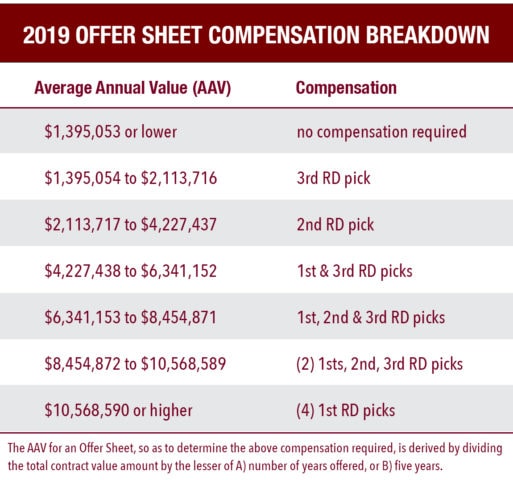
Of course, should a team successfully offer sheet a player for four first-round draft picks, that team no longer has four years of firsts… the very pipeline of prospect pools.
The Value of Four First Rounders
Surrendering four first-round picks isn’t like ripping a Band-Aid off and feeling a brief tinge of pain; it’s ripping one off for four consecutive years. Even seemingly strong teams with some unfortunate injuries and bad puck luck can fall out of contention and into the draft lottery. And the mere thought of losing a possible high first-round draft pick is damaging. Offer sheet picks cannot be lottery-protected.
If the Maple Leafs lose Marner to an offer sheet, they’ll recoup four first-round picks and have the cash to pursue a UFA or RFA. It’s hardly the end of the world. They could also flip one or two of the first-round picks for a much-needed top-four blueliner or top-six winger. In fact, losing Marner to an offer sheet may be exactly what Dubas wants. It would rescue him from the cap debacle that he caused, and give him the picks to trade or draft to replace Marner.
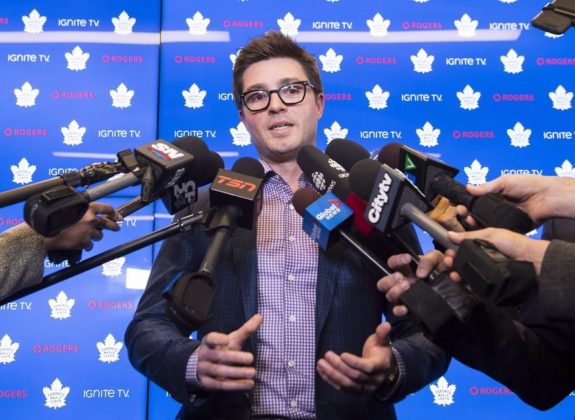
“If there were an offer sheet, we would look at what they are, what the compensation is for our team, and make the decision based off of that,” said Dubas. “It’s our intention they’re all here for as long as we can possibly keep them. If the dollar amount doesn’t make sense in terms of our internal economics and the marketplace, and the compensation is such, it’s going to be a decision as to what we’re going to do.”
Valuing a First-Round Pick
First round picks, especially those outside of the top-10, are often overvalued.
- Of the 2018 first-round draftees taken after the No. 10 pick, only Isac Lundestrom (15 games) saw any NHL action.
- Of the 2017 first-round draftees taken after the No. 10 pick, only three players have seen more than 26 games of NHL action. They are Filip Chytil (84 games), Robert Thomas (70 games) and Henri Jokiharju (38 games).
- Of the 2016 first-round draftees taken after the No. 10 pick, only three players have seen more than 68 games of NHL action. Charlie McAvoy (117 games), Jakob Chychrun (171 games) and Tage Thompson (104 games).
- Of the 2015 first-round draftees taken after the No. 10 pick, only 10 players (half of those selected) have seen more than 94 games of NHL action.
- Of the 2014 first-round draftees taken after the No. 10 pick, only 10 players (half of those selected) have seen more than 133 games of NHL action.
In summary, of the roughly 150 players drafted after the No. 10 pick in each of the last five years, only 27 of them (18 percent) have played more than a third of their team’s games. Put another way, dating back to 2014, there’s an 80 percent chance a player chosen in the first round, starting with pick No. 11, has played less than a third of his team’s games.
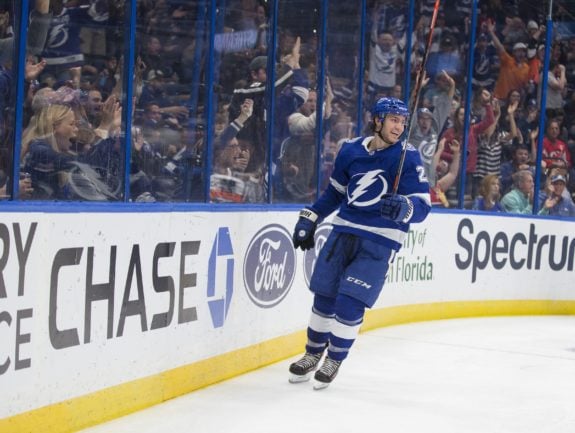
This link shows what each team can offer in an offer sheet based on the compensation of AAV.
Offer sheets favor better teams versus those that are rebuilding and struggling. It’s simple math. Consider a team like the Bruins to offer sheet Marner vs. the Senators. The Bruins, with a core built for success, likely will give up assets in the 20th spot to the 31st for the next few years while the Senators picks will likely be in the top 15 for the next few years. Teams can have quick turnarounds, but they’re outliers.
A team like the Buffalo Sabres is so poor at drafting and developing that giving up four draft picks for Marner or McAvoy or Point or whoever is probably smart.
One Critical Week
The majority of unrestricted free agents gets scooped up in the first few days of the free agency window opening. Teams have one week to decide if they will match an offer sheet for an RFA. It can seem like an eternity for the team extending the offer. There’s also a possibility they could miss out on a UFA on their list while waiting for resolution on the RFA. it’s highly unlikely a team could offer sheet Marner and go after Panarin. If the Leafs match the sheet, chasing Marner could cost them Panarin.
Dubas has stated that matching an offer sheet for Marner is not guaranteed. It could be a bluff or he could opt to take the picks and use them toward a blueliner he desperately needs. It’s all a game of chess and poker. Young RFAs want what they think they’re worth. GMs generally have all the control and leverage. That is, until their solidarity is broken.
Salary Cap Strapped Teams
The cap was thought to advance as high as $83 million this year. The fact that it was set at $81.5 million is pinching some teams that planned on it being more.
It’s not just a salary that has to be matched, it’s the term and payment schedule. Conniving GMs who are serious about luring a player can structure a contract to deter a team from matching their offer. Hockey may be a sport, but it’s also a very competitive business. Front loading a deal could create an extra-level of havoc for some teams against the cap. The Carolina Hurricanes might not be able to match a heavily, front-loaded deal for Aho. And teams that match an offer are not allowed to trade the player for a full year.
Not all offer sheets cost four first-round picks. An offer sheet of five years at $10.4 million AAV would only cost two first rounders plus a second and third. The assumption is the offer would be matched. However, the threat of that a five-year $10.4 AAV offer sheet sets a floor for nearly all of the elite-level RFAs.
An offer sheet could be more possible and practical for a mid-to-high level guy. A cap-crunched team like the Jets would be in a pickle if a team offered $8 million AAV for Kyle Connor. Yet the price would be quite reasonable–a first, second and third-round pick.
L-L-L-Laine and the Jets
Bridge deals can be an opportunity for a young player to prove their worth and cash in bigger on their next contract.
Winnipeg RFA Patrik Laine is an interesting case. The 21-year-old 2016 second-overall pick has already put up 110 goals and 74 assists in 237 NHL games. Only five players scored more goals in that period. The sniping Laine potted more goals than Sidney Crosby, David Pasternak, Patrick Kane and Vladimir Tarasenko.
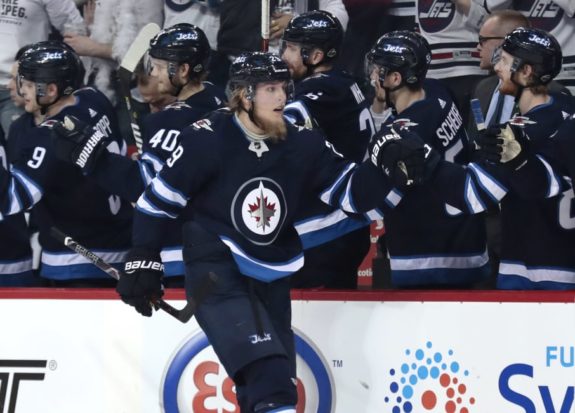
Though the 2018-19 season saw his production trail off, Laine and his agent Mike Liut will bet on his ability to return to his 70-point sophomore season. If Jets GM Kevin Cheveldayoff can’t get him locked up in a long-term deal, Laine may be fine with a two-year bridge deal. There are several examples of teams and players to have gone done the bridge deal route, including Nikita Kucherov and Artemi Panarin, both inked in 2016.
Ahem…Aho
The Canes’ Sebastian Aho is a prime candidate for an offer sheet. The 21-year-old forward is already a dynamic difference maker, with 197 points in 242 games.

The Rauma, Finland native would probably be more than happy to sign a five-year, $9 million offer sheet that would cost a team two firsts, a second and a third-round pick. The Canes may not be able or willing to match the deal.
Decisions, Decisions
Winning is really hard in the NHL. While every GM wants to put together a winner, they’ve been reluctant to use offer sheets. With so many high-end, quality RFA players available, if ever there was a year for offer sheets, this is it.